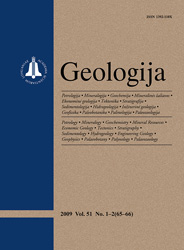Geologija / Geology
WHAT?
 ISSN 1392-110X ISSN 2029-056X (online) |
2011 m. Nr. 3 Prospects for CO2 geological storage in deep saline aquifers of Lithuania and adjacent territories
Carbon dioxide emission to the atmosphere is one of the most urgent global-scale ecological problems. A large amount of gas emitted since the nineteenth century has led to a 0.5 °C climate warming which seems to progress. Different possibilities of eliminating CO2 have been considered over the past decades, but no effective method has been developed so far. The geological storage of CO2 is regarded as one of the most mature technologies. Depending on geological conditions, several types of geological formations, such as deep saline aquifers, depleted oil / gas fields and coal seems, are considered as potential geological formations for CO2 storage. The Baltic sedimentary basin contains several large deep saline reservoirs. Our study shows that only the Cambrian aquifer representing the basal part of the sedimentary cover can be used for the geological storage of carbon dioxide. The practical storage capacity of Lithuania is evaluated as low. On the other hand, a higher-risk scenario implies a rather large storage potential in West Lithuania. Keywords: CO2 emissions, the Baltic, geological storage, saline aquifer, structural trap |
Issues:
2011 - Vol.53 No. 1, No. 2, No. 3 2010 - Vol.52 No. 1-4 2009 - Vol.51 No. 1-2, No. 3-4 2008 - Vol.50 No. 1, No. 2, No. 3, No. 4, No. Priedas 2007 No. 1, No. 2, No. 3, No. 4 2006 No. 1, No. 2, No. 3, No. 4 2005 No. 1, No. 2, No. 3, No. 4 2004 No. 1, No. 2, No. 3, No. 4 2003 No. 1, No. 2, No. 3, No. 4 2002 No. 1, No. 2, No. 3, No. 4 2001 No. 1, No. 2, No. 3, No. 4 |